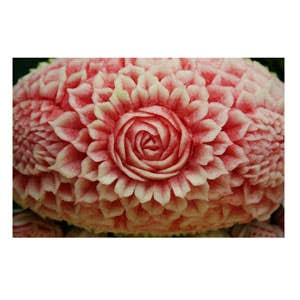
An Ancient Art
Mention watermelon carving to most people in this country, and they'll probably think of a hollowed-out, melon ball-filled watermelon "basket". In Thailand, however, the elaborate carving of watermelon and other fruits and vegetables is a long-standing and respected tradition that dates to the 14th century, when the art evolved in the court of King Phra Ruang. Chefs for Thai nobility and royalty were expected to make food that was not only delicious but also beautiful, even fantastical. Today in Thailand, carved fruits and vegetables are presented as religious offerings, used as displays at weddings and banquets, and entered into judged competitions. Kalaya Tongchareon Paragas, a 55-year-old Thai immigrant who lives in Long Island, New York, has been carving vegetables and watermelons—like the many-petaled one shown—since she was in her teens as a way of continuing and honoring the traditions of her native land. Though she learned the basics of carving in middle school using pieces of ginger, Paragas has recently taught herself more-complicated techniques by reading books on the subject and swapping advice with friends. Today, she teaches carving classes and creates elaborate centerpieces for events at her local Buddhist temple. When asked what her next masterpiece would be, Paragas laughed and said, "My 15-year-old son wants me to make a Pokemon."
Keep Reading
Continue to Next Story










